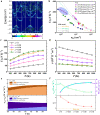Vacancy-mediated anomalous phononic and electronic transport in defective half-Heusler ZrNiBi
- PMID: 37543679
- PMCID: PMC10404254
- DOI: 10.1038/s41467-023-40492-7
Vacancy-mediated anomalous phononic and electronic transport in defective half-Heusler ZrNiBi
Abstract
Studies of vacancy-mediated anomalous transport properties have flourished in diverse fields since these properties endow solid materials with fascinating photoelectric, ferroelectric, and spin-electric behaviors. Although phononic and electronic transport underpin the physical origin of thermoelectrics, vacancy has only played a stereotyped role as a scattering center. Here we reveal the multifunctionality of vacancy in tailoring the transport properties of an emerging thermoelectric material, defective n-type ZrNiBi. The phonon kinetic process is mediated in both propagating velocity and relaxation time: vacancy-induced local soft bonds lower the phonon velocity while acoustic-optical phonon coupling, anisotropic vibrations, and point-defect scattering induced by vacancy shorten the relaxation time. Consequently, defective ZrNiBi exhibits the lowest lattice thermal conductivity among the half-Heusler family. In addition, a vacancy-induced flat band features prominently in its electronic band structure, which is not only desirable for electron-sufficient thermoelectric materials but also interesting for driving other novel physical phenomena. Finally, better thermoelectric performance is established in a ZrNiBi-based compound. Our findings not only demonstrate a promising thermoelectric material but also promote the fascinating vacancy-mediated anomalous transport properties for multidisciplinary explorations.
© 2023. Springer Nature Limited.
Conflict of interest statement
The authors declare no competing interests.
Figures





References
-
- Chen C, et al. Atomic line defects and zero-energy end states in monolayer Fe(Te,Se) high-temperature superconductors. Nat. Phys. 2020;16:536–540. doi: 10.1038/s41567-020-0813-0. - DOI
Grants and funding
LinkOut - more resources
Full Text Sources

